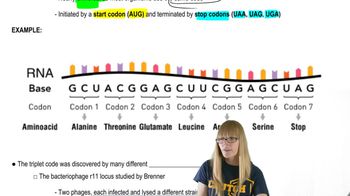Table of contents
- 1. Introduction to Genetics51m
- 2. Mendel's Laws of Inheritance3h 37m
- 3. Extensions to Mendelian Inheritance2h 41m
- 4. Genetic Mapping and Linkage2h 28m
- 5. Genetics of Bacteria and Viruses1h 21m
- 6. Chromosomal Variation1h 48m
- 7. DNA and Chromosome Structure56m
- 8. DNA Replication1h 10m
- 9. Mitosis and Meiosis1h 34m
- 10. Transcription1h 0m
- 11. Translation58m
- 12. Gene Regulation in Prokaryotes1h 19m
- 13. Gene Regulation in Eukaryotes44m
- 14. Genetic Control of Development44m
- 15. Genomes and Genomics1h 50m
- 16. Transposable Elements47m
- 17. Mutation, Repair, and Recombination1h 6m
- 18. Molecular Genetic Tools19m
- 19. Cancer Genetics29m
- 20. Quantitative Genetics1h 26m
- 21. Population Genetics50m
- 22. Evolutionary Genetics29m
11. Translation
The Genetic Code
Problem 5b
Textbook Question
Textbook QuestionA portion of a DNA template strand has the base sequence 5′-...ACGCGATGCGTGATGTATAGAGCT...-3′
Identify the sequence and polarity of the mRNA transcribed from this fragmentary template-strand sequence.
 Verified Solution
Verified SolutionThis video solution was recommended by our tutors as helpful for the problem above
Video duration:
3mPlay a video:
Was this helpful?
Key Concepts
Here are the essential concepts you must grasp in order to answer the question correctly.
Transcription
Transcription is the process by which the genetic information encoded in DNA is copied into messenger RNA (mRNA). During transcription, RNA polymerase binds to the DNA template strand and synthesizes a complementary RNA strand. The RNA is synthesized in the 5' to 3' direction, meaning that the RNA strand will have a polarity opposite to that of the DNA template strand.
Recommended video:
Guided course

Eukaryotic Transcription
Base Pairing Rules
Base pairing rules dictate how nucleotides pair during the transcription process. In RNA, adenine (A) pairs with uracil (U) instead of thymine (T), which is found in DNA. Therefore, when transcribing a DNA sequence, cytosine (C) pairs with guanine (G), guanine (G) pairs with cytosine (C), adenine (A) pairs with uracil (U), and thymine (T) pairs with adenine (A).
Recommended video:
Guided course

Base Distortions
Polarity of Nucleic Acids
Nucleic acids, including DNA and RNA, have directionality or polarity, indicated by the 5' and 3' ends. The 5' end has a phosphate group, while the 3' end has a hydroxyl group. This polarity is crucial during transcription, as RNA polymerase adds nucleotides to the 3' end of the growing mRNA strand, resulting in an mRNA molecule that is complementary to the DNA template strand and has a 5' to 3' orientation.
Recommended video:
Guided course

Point Mutations

 11:43m
11:43mWatch next
Master The Genetic Code with a bite sized video explanation from Kylia Goodner
Start learningRelated Videos
Related Practice


